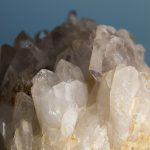Tugtupite was first discovered in 1960 in Greenland, where it is craved for jewellery. Colors include dark red to bright pink, and shades of orange. It may look mottled. When it is placed in the dark, the paler parts of the rock fade to white, but exposure to light restores the color.
Tugtupite is found as massive opaque material in pegmatite veins. It also occurs in northern Russia.
The name derives from its occurrence in Tugtup, Greenland, and means reindeer stone.




























Leave a Reply
You must be logged in to post a comment.